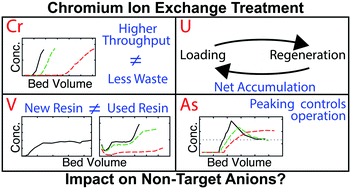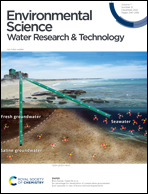Removal of hexavalent chromium by anion exchange: non-target anion behavior and practical implications†
Abstract
Ion exchange is effective for hexavalent chromium removal from drinking water sources, but non-target anions (i.e., arsenic, vanadium, and uranium) that co-occur must be assessed to inform, design, and implement operational strategies. Three strong base ion exchange (SBIX) resins were pilot tested. The macroporous polyacrylic resin had a higher chromium capacity relative to two gel polystyrene resins. However, the broader regeneration elution peak of the macroporous polyacrylic resin negated the advantages of higher resin capacity by producing more waste. Even when arsenic is below regulatory limits in the raw water, arsenic chromatographic peaking may control the number of resin contactors required for a full-scale design and inform the offset between parallel contactors. Regeneration efficiency was poor for both vanadium (15–51%) and uranium (21–70%). Poor vanadium regeneration efficiency, in combination with unique breakthrough curves, suggest that vanadium speciation is transforming in the resin phase to polynuclear complexes. Poor uranium regeneration efficiency would lead to accumulation above 0.05% wt within 3 loading-regeneration cycles, potentially triggering controlled disposal due to radioactivity. This study demonstrates that the behavior of non-target anions can heavily influence full-scale design and operation and should be considered during all phases of testing.



 Please wait while we load your content...
Please wait while we load your content...